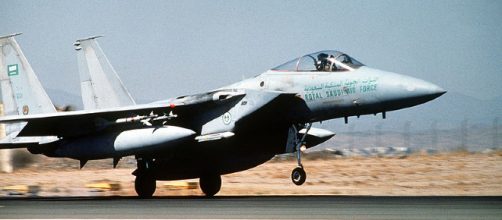The civil war in Yemen took a very interesting turn this week because of one Saudi F-15 fighter jet. According to Shia Houthi rebels, the Saudi aircraft was shot down not far from the Yemeni city of Sa'da. Videos and images uploaded to Twitter and other social media platforms appear to show a Houthi-operated surface-to-air missile, or SAM, knocking the jet out of the sky. The Saudi Press Agency claims that the jet managed to survive its shootout with the Houthi SAM. The March 21st attack, which the Saudi military claims was launched from the Sa'da airport, did not halt the F-15's mission nor disable the aircraft.
This back and forth game may have deadly consequences. The Saudi military has long maintained that Yemen's Houthis are being supplied with state-of-the-art weapons systems from Iran, Saudi Arabia's main rival in the region. In Tehran, the Iranian regime claims that the Saudi military has illegally intervened in Yemen's civil war, and also claims that Saudi Arabia is guilty of war crimes. Recently, a bipartisan bill sponsored by Senators Bernie Sanders (I-VT), Mike Lee (R-UT), and Chris Murphy (D-CT) failed to pass in the U.S. Senate. This resolution called on the U.S. to stop funding the Saudi military's campaign in Yemen because of human rights concerns.
The F-15 in question most likely came from the United States.
Originally created in the early 1970s by McDonnell Douglas and manufactured by Boeing, this fighter jet is currently a part of the arsenals of the U.S. Air Force, along with the allied air forces of Saudi Arabia, the Kingdom of Jordan, Israel, and Japan.
Humanitarian crisis
The Yemeni Civil War first began in 2015 when the Houthis, who are originally from the area of Sa'da, began intensifying their rebellion against the government of Abdrabbuh Mansur Hadi. At the same time, Yemeni soldiers still loyal to former president Ali Abdullah Saleh attacked an airport in the major port of Aden on March 19, 2015. Yet another group, the Islamic State, began a wave of mosque bombings throughout the country.
Since that time, Yemen, a highly fractious and traditionally federal nation with a strong tribal identity, has been divided between several warring militias. The Houthis control a large swath of the country's northwest, including the capital city of Sana'a. The forces loyal to President Hadi, who receive financial and military support from Saudi Arabia, the United States, and the United Arab Emirates, control large portions of the south, center, and far east of the country. The Islamic State and Al-Qaeda in the Arabian Peninsula (AQAP) control several cities, while Aden is dominated by the Southern Transitional Council, a party that seeks to create an independent state.
International aid agencies claim that thousands of Yemeni civilians have been killed in airstrikes conducted by the Royal Saudi Air Force.
The United Nations puts the exact civilian death toll since March 2015 at 5,144. Approximately 20 percent of those killed have been children, according to the UN.
Battle for Saudi soil
Despite being larger and better equipped than the Houthis, the Saudi military has had an exceptionally hard time in defeating the Shia insurgency on its own doorstep. In fact, Houthi militiamen control several villages in the Saudi provinces of 'Asir, Najran, and Jizan. Saudi troops and Houthi rebels are currently fighting over the Saudi city of Najran. The Houthis have managed to fire missiles into Saudi territory, and have even targeted major oil companies in the Gulf kingdom, such as Aramco.
On the international stage, U.S.
President Donald Trump and Saudi Crown Prince Mohammad bin Salman have grown closer over Salman's promise to root out jihadist terrorism in Saudi Arabia. It remains to be seen if U.S. forces, which have conducted airstrikes and special operations in Yemen since 9/11, will become more involved in the conflict.


